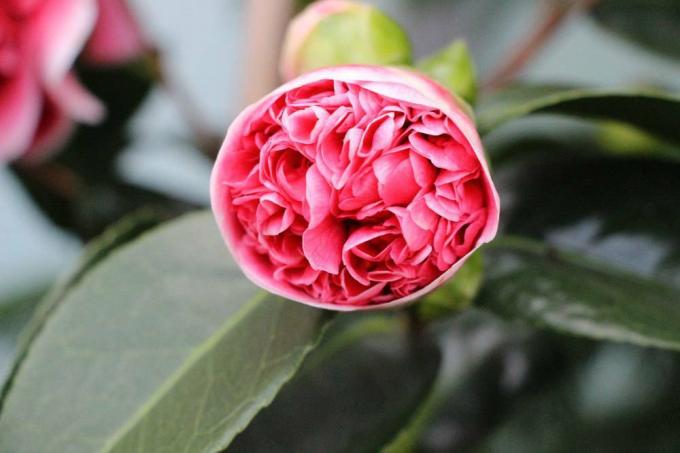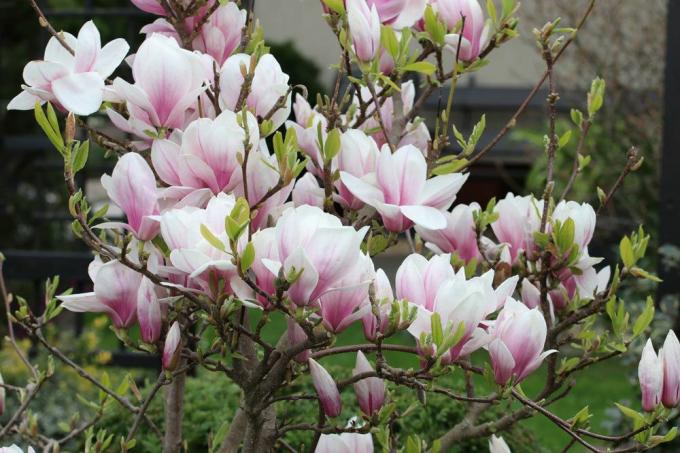
table of contents
- Shrub or tree?
- Planting time
- Location
- Substrate
- Magnolia plants - instructions
- preparation
- Planting pit
- Planting
- Rework
While the magnolia already knows how to convince as a shrub with its lush, almost unique blossoms, as a tree it becomes the focus of every ornamental garden. In addition, with over 100 cultivated varieties, it is not only the oldest, but also the very rich representative of flowering plants. In the following instructions we will tell you how to plant a magnolia in your home garden.
Shrub or tree?
Which of the numerous magnolia varieties is the perfect choice for your own garden certainly depends first and foremost on the visual preferences of the hobby gardener. Because not all magnolia trees are the same. In addition to the growth size, the individual plants also differ in their flower shape and are divided into the large groups of star magnolias and tulip magnolias. In terms of their location, soil and care requirements, however, the different varieties are so close together that that in addition to the appearance, the available space is the decisive factor when deciding on a shrub or tree should.
Planting time
Usually, shrubs and trees are assumed to be replanted in late summer and autumn, or in early spring. With magnolias it has been shown that spring is preferable. Since the plants also develop roots intensively in the uppermost layer of the earth, there is a risk of major damage from low temperatures and frost if planted before winter.
Location
The ideal place for the magnolia can be easily described in a few words:
- Bright
- Sunny
- Sheltered from the wind
Note: Although magnolia plants are considered to be lovers of full sun locations, they can also tolerate a location that is not directly facing south. Whether facing south-west or south-east, the locations can vary up to a partially shaded, but nevertheless wind-protected and bright place.
Substrate
Once the right location for the magnolia has been found, it is important to provide it with the optimal growth conditions at this location. Like most plants, it has specific requirements for the soil in which it should thrive:
- Heavy soil, without too high a proportion of sand or clay, not too loose
- Good water storage capacity for ideally permanently slightly moist soil
- High proportion of humus for a good supply of nutrients
- Slightly acidic soil, pH between 5.5 and 6.8
- Low lime content (with a few exceptions among the magnolia species)
Since hardly any naturally occurring soil in the garden has all these properties by itself, a little tuition is usually required for the benefit of the magnolias. The optimal substrate can be achieved with little effort with the following steps:
- Addition of up to 1/3 humus
- Fold in the acidic rhododendron soil
- Alternatively: use bark humus instead of rhododendron earth, but clarify beforehand whether the selected magnolia variety is compatible!
tip: Cover the improved soil with bark mulch to prevent premature drying out and to keep moisture in the root area
Magnolia plants - instructions
If the location and substrate match the needs of the magnolia, then the actual planting begins. The work steps described below help to carry out all essential work in a simple and targeted manner and not to forget any essential steps:
preparation
Magnolias are mostly called Ball plants offered. This means that the shrub or tree is removed at the place of rearing, together with the root ball and the surrounding soil and passed on. After purchasing, you should shake off or wipe the loose soil from the root ball, as it is often very depleted and does not meet the requirements already described. If necessary, it can be mixed in with the soil improvement in order to avoid the disposal of the earth.
Attention: The soil should never be cut from the root ball or removed mechanically in any other way. There would be a high risk of damaging the fine roots and root hairs, making it even more difficult for the magnolia to grow.
Planting pit
When you arrive at the new location, you need to dig a suitable hole for the new plant. The diameter and depth of the pit depend on the size of the plant and, above all, the root ball. For easy planting and above all good development opportunities, it is usually recommended to choose about twice the diameter and one and a half times the depth of the root ball for the pit.
Note: Numerous advisors recommend first digging the pit and then carrying out the soil improvement measures in it. If you choose this way, the hole should be designed as generously as possible. Otherwise magnolias can be subject to a growth shock if the tender roots suddenly reach the "worse" environment at the edge of the planting pit. We therefore recommend extensive soil improvement, which will also bring benefits to the plant in the medium and long term, before the planting pit is created.
Planting
Now the plant is carefully inserted into the prepared hole. There are two ways of doing this. Small plants can be kept well and then filled on all sides. In the case of larger specimens, on the other hand, it is worth putting some prepared soil into the hole first, then placing the root ball on it and then filling it in from all sides. The filled earth should be firmly pressed or trodden on in order to prevent the magnolia from settling too hard and possibly tipping over. Don't worry, even well-trodden soil is still loose from the plant's point of view and therefore well suited for the formation of new roots.
It has proven to be good practice to carry out the filling step by step and to keep pressing the soil in place. In the case of larger planting pits, you will otherwise have to refill soil after a few watering processes, as it will settle again anyway due to the wash-in of the irrigation water.
Rework
To give magnolias a good start after setting, you should water them carefully. You should also water regularly in the coming days, as soil moisture is one of the main factors for good root formation. In order to keep the moisture in the soil for a long time, the soil above the root ball can also be used Bark mulch be covered. This reduces evaporation and supports the moisture and temperature balance of the soil.





